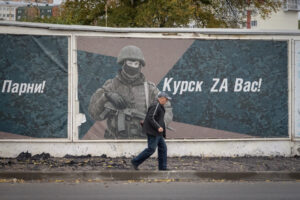The issue has become increasingly thorny for European politicians, and analysts say several countries could see their governments face the same fate as recently befell the Netherlands.
The issue of immigration has claimed yet another elected leader who found himself after a lengthy political drama unable to navigate between the demands of those who fear that an expanding influx of migrants is straining limited government resources beyond capacity and those who argue that policies effectively keeping families apart are cruel.
But this turmoil didn’t take place in California or Texas or Arizona or New Mexico – where the border is arguably the most hardened, politically divisive issue in the land. It occurred in the Netherlands.
The resignation of long-serving Dutch Prime Minister Mark Rutte last month came after the government coalition he led failed to come to an agreement on how to stem the flow of refugees into his country. The move is the latest example of the politics of migration becoming an increasingly challenging predicament for officials across Europe, with far-right parties using their rising influence to put the idea of reducing immigration on the table.
The issue has cleaved America. Long characterized as a nation of immigrants, immigration in the U.S. has nevertheless become the foundation of one party that largely characterizes both legal and illegal immigration as undesirable and another that insists on its social, economic and humanitarian benefits – and both so hardened in their positions to preclude even any common-sense reforms.
But in Europe, where national identities have been crafted over centuries of commonality in heritage, language, religion, custom and history, the immigration debate threatens to be far more destabilizing. With one coalition already toppled in the Netherlands, experts say similar issues face leaders in Germany and Italy – and perhaps even France and Spain.
This all comes as the continent grapples with an uptick in migration that has occurred over the past decade. As of July 30, more than 127,000 migrants have arrived across Europe in 2023 – on pace to exceed last year’s figure, which reached almost 190,000.
The large majority are coming by sea, according to data from the United Nations’ International Organization for Migration. The U.N. refugee agency reports the most common nationalities among the tens of thousands of arrivals in the Mediterranean region since January 2021 have been migrants from Tunisia and Egypt.
Last year’s numbers constitute a spike following a predictable dip during the height of the COVID-19 pandemic. But even before the pandemic, the numbers weren’t nearly as high as they’ve been recently since 2017 – not long after the start of the continent’s refugee crisis in 2015, which snowballed from the Arab Spring in 2011 through the intensifying Syrian civil war and the march of the Islamic State group that displaced millions. Complicating matters more recently is Russia’s invasion of Ukraine.
“European countries have been quite stressed and stretched over the last year and a half by the Ukraine crisis,” says Susan Fratzke, a senior policy analyst at the Migration Policy Institute’s international program.
Fratzke refers to the issues of housing and school capacity in European countries as well as reported “burnout” among resettlement staff. While this isn’t an “entirely new phenomenon” after the refugee crisis from about seven years ago, she also notes that because of the special temporary protection status given to Ukrainians by the European Union, their migration numbers are reported separately from the already high asylum applications across the continent.
Government officials in several countries have, for the most part, responded to the increased flows not necessarily in a “delicate” way but instead by “turning to tools that try to just close down access to everyone,” Fratzke says.
“Those are really blunt tools that aim to just discourage anyone from arriving, rather than sort of trying to preserve access for people who might genuinely be in need of protection as refugees,” she adds. “Because it’s very difficult for governments to fine-tune some of these systems that sort of sort through those two groups, and they want things that respond to political and public concerns about needs for order and legality quickly.”
Which is exactly what happened in the Netherlands in early July.
The ruling coalition’s four parties – the People’s Party for Freedom and Democracy (or VVD), the Christian Democratic Alliance (CDA), the Democrats ’66 (D66) and the Christian Union – could not agree, with the first two in favor of a crackdown on immigration and the latter two against it.
The latest proposals offered among the government coalition before Rutte’s resignation, according to the AP, included creating two classes for the asylum system – a temporary version for people fleeing conflicts and a permanent version for people escaping persecution – and reducing the numbers allowed for family reunification.
Analysts say that Rutte’s centrist VVD party was at least in part influenced to stand behind stronger measures on immigration due to the growing support in the country for the Party for Freedom (or PVV), a far-right populist party.
“The center-right is like, ‘Uh-oh, we’re going to lose our electorate, right?’ So we need to position ourselves to be a little tougher on immigration so we can keep the vote away from the far-right party,” says Carolyn Dudek, a professor and director of European studies at Hofstra University. “My supposition is that there was a sense of like, ‘We need to outflank the far-right, and this is how we do it.’”
Much as Donald Trump rose to prominence on the back of disparaging comments about immigrants while announcing for president in 2015, these types of political parties have been gaining influence not just in the Netherlands but across Europe as well. Leaders from far-right groups have been elected in countries such as Italy and Sweden – and many of the parties they represent base a large part of their platform on anti-immigration sentiment.
“It’s been a hot-button issue for a very long time,” says Vivien Schmidt, a professor at Boston University and founding director of the university’s Center for the Study of Europe. “It’s been the major focus of extreme right parties that have used it to great success, really.
“It’s a political force,” she adds.
These sentiments have been found in European publics for years now, gaining relevance after the refugee crisis of 2015. A survey from the nonpartisan Pew Research Center published in 2019 found majorities in five nations – Greece, Hungary, Italy, Germany and Sweden – wanting their respective country to allow fewer or no more immigrants to move there. It’s also seen by Europeans as one of the most important issues they face, according to a 2021 survey from the European Commission.
Anthony Messina, a professor of political science at Trinity College, says his research shows that fear about the “erosion of their national or, in some cases, their sub-national culture” is motivating people to vote on the basis of immigration.
He says immigration is becoming a much more “politically salient” issue – meaning the electorate is more engaged with it – and that migration is actually driving far-right parties to more electoral votes and, as a result, more sway when it comes to policymaking.
“It’s not that anti-immigrant sentiment is historically high. It’s quite the contrary,” adds Messina, author of the forthcoming book, “Immigration, Security and the Liberal State.” “But it’s energized a fragment or a segment of the electorate to a degree that is showing up in support for far-right or extreme-right parties.”
Countries with generous social welfare programs – such as France, Italy and Scandinavian nations – have long been attractive destinations for many migrants in the region, with swaths of them traveling through Europe to get there. It’s another aspect of the debate that informs why some locals in these types of European countries are starting to turn on immigration.
Edward Koning, an associate professor at Canada’s University of Guelph in Ontario, advances another theory related to sentiments about migration, known as the “losers of modernization.”
“This is essentially the argument that people who are losing out to globalization because they have skills that are not wanted in the international economy are also sort of most likely to live in neighborhoods where many immigrants live,” Koning says. “Their everyday experience is that the traditional politics is not taking care of them. They can relate to things they see in their everyday lives in terms of feeling that, indeed, maybe a restriction on migration is what the country needs.”
People with these views align themselves with parties that “make a lot of hay about migration” – even if some of these parties make “empty promises” based on misdiagnosing inequality as being driven by an increase in immigration numbers, Koning adds.
Whether a situation similar to what happened in the Netherlands could arise elsewhere in Europe, analysts say a few countries come to mind.
Fratzke, of the Migration Policy Institute, highlights Germany, where the far-right, anti-immigration Alternative for Germany party is gaining polling ground and finding some success in local elections. Adding fuel to the comparison, Fratzke describes the German government coalition as a “three-legged stool” which has been “ungainly.” The coalition has also dealt with infighting lately, as reported by Reuters.
Elsewhere, Italy – with a newly elected far-right prime minister, Giorgia Meloni – has been front and center on the migration debate, given its status as a destination of a lot of irregular routes on the Mediterranean. Indeed, it’s one of the southern European countries “taking the brunt of” the increase in immigration, according to Dudek. More recently, Meloni has softened her usually hard-line stance on the issue. But Italian Deputy Prime Minister Matteo Salvini still holds influence in the government and has long taken a stronger anti-immigrant stance as a populist, dating back to his term as the country’s interior minister, notes Schmidt.
Analysts also name France, due to the country’s recent strife amid massive protests that have led some to believe the government is on shaky ground. But the next presidential election isn’t until 2027, and President Emmanuel Macron managed to hold off far-right politician Marine Le Pen in last year’s contest. Spain could be another possibility, with the rise of the far-right, anti-immigration political party known as Vox. While the party performed worse than anticipated in the country’s July 23 election, it could still become part of the ruling coalition depending on government negotiations.
Regardless, immigration will likely remain a polarizing issue in Europe – and other parts of the world – for the foreseeable future, and it’s not so cut-and-dry politically. Schmidt points to Denmark, where the center-left government has even taken up some of the strict immigration views of the country’s own far-right party.
“Nothing,” she says, “is predictable anymore.”
Source: US News
































